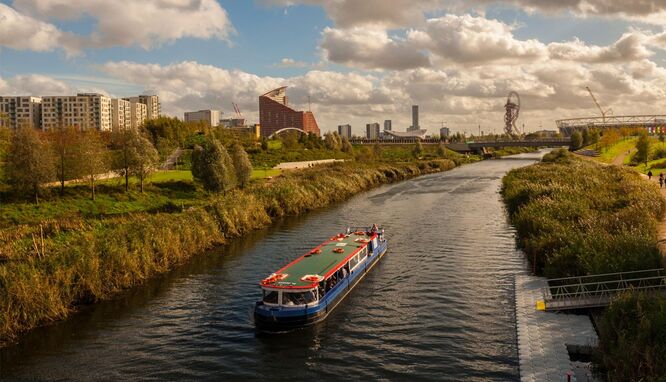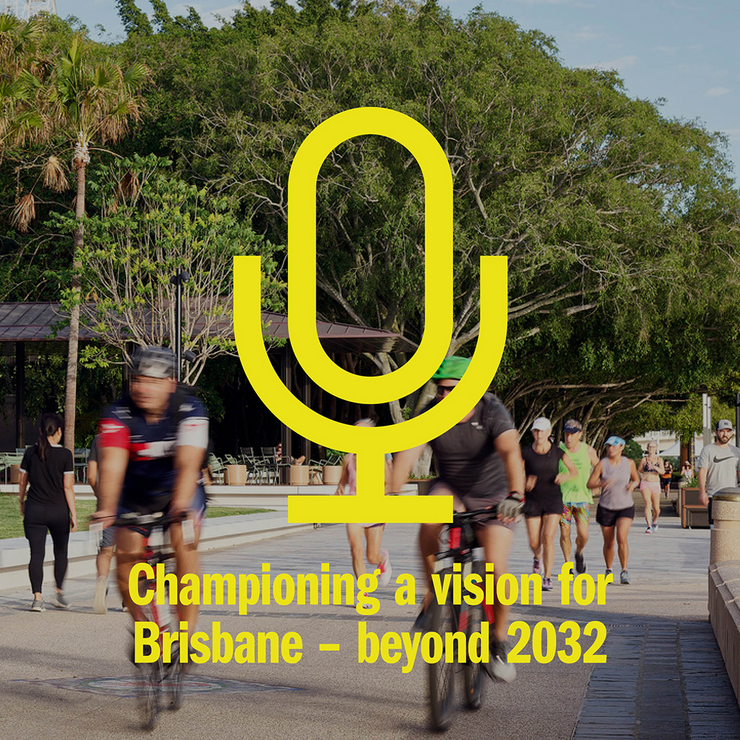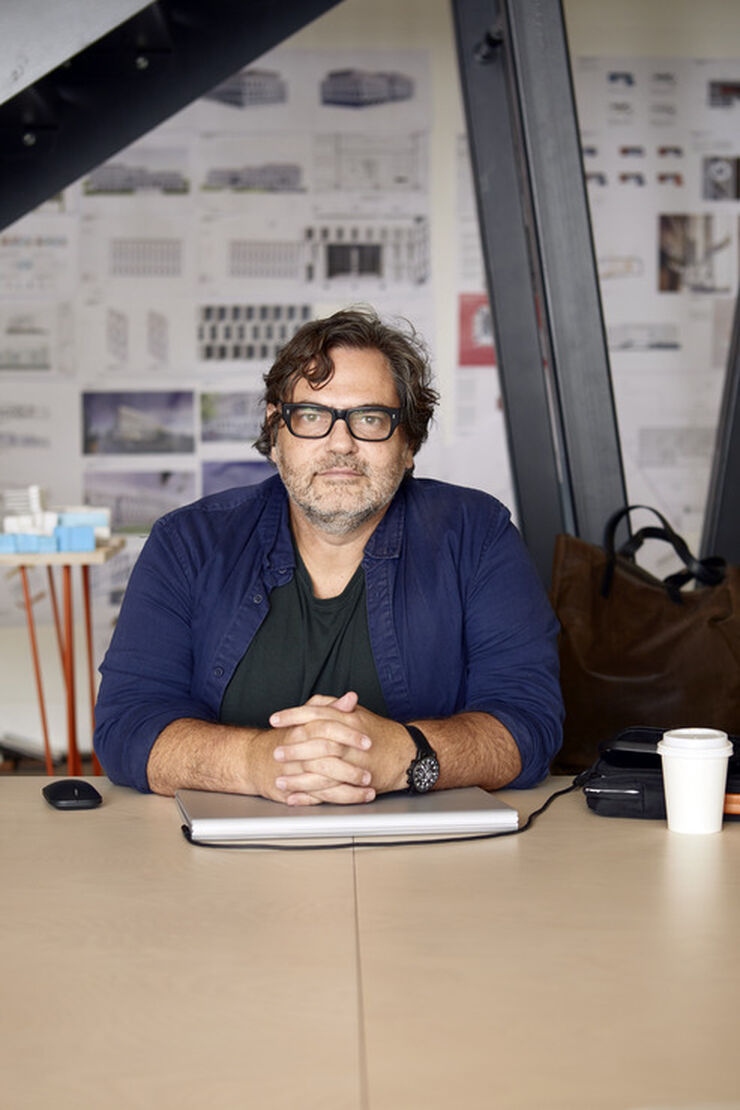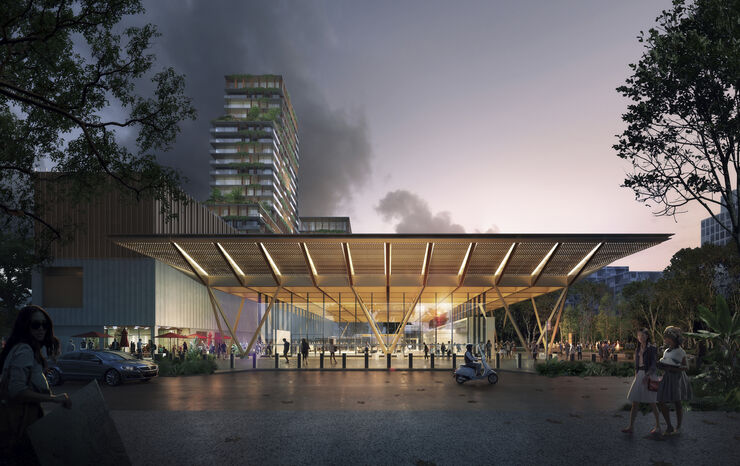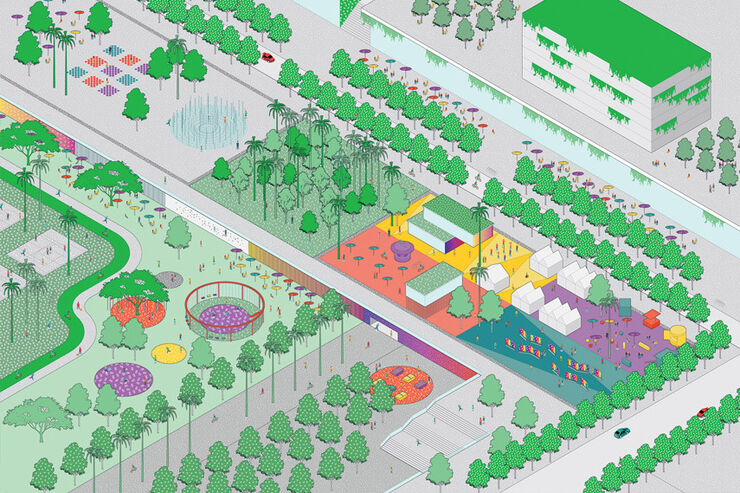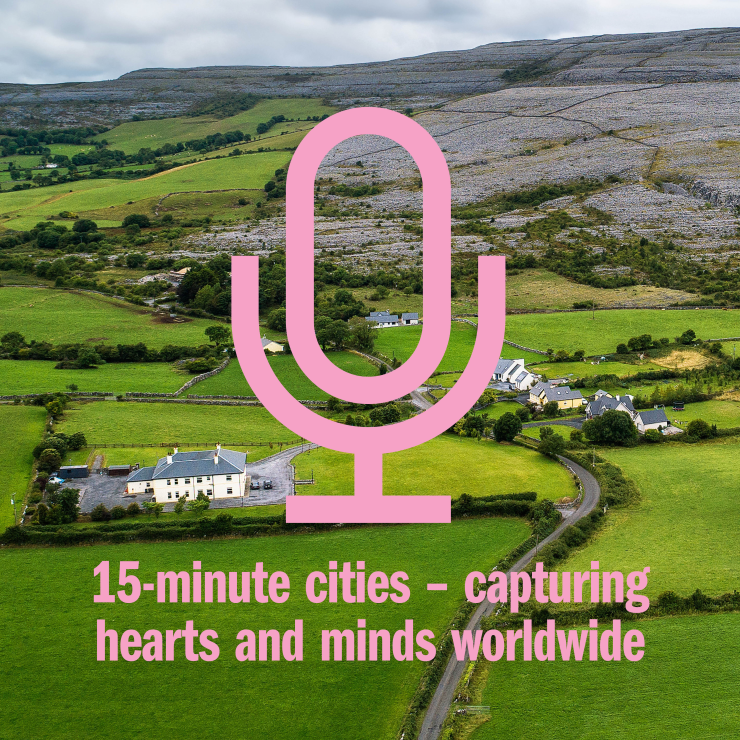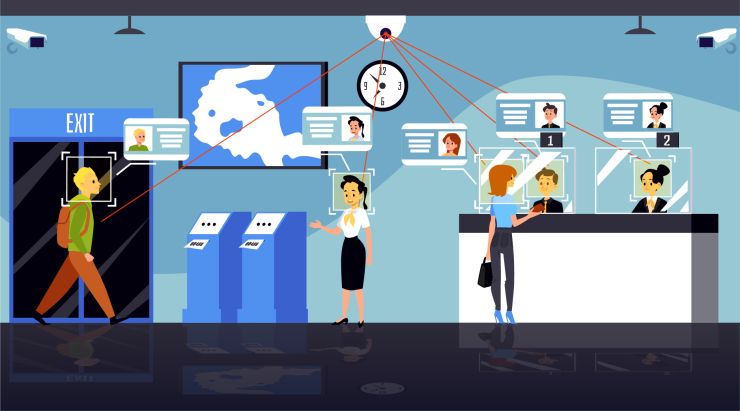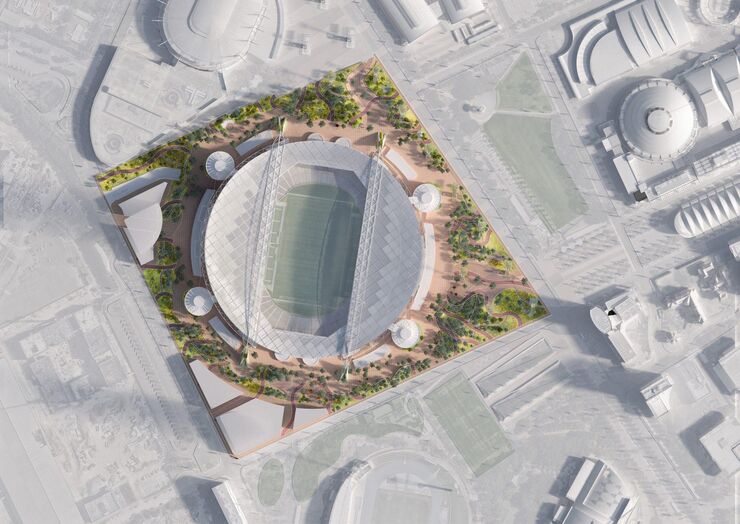Transcript
Music plays.
Caroline Stalker introduces the episode
From Global Design Practice, Hassell. This is Hassell Talks, a podcast series passionate about the transformative power of design to make the world a better place. I’m Caroline Stalker and I’m an architect, urbanist and a principal at Hassell. I’m here on Jagerra and Turbal Country in Brisbane and I pay my respects to elders past, present and emerging. I’m delighted to be stepping back into the hosting hot seat. In this episode we’ll be sharing more insights with you in into how we are looking at the opportunities for Brisbane ahead of the 2032 Olympic and Paralympic games. In the previous Olympics episode, season five, episode one. Do go back and have a listen if you haven’t had a chance to already. We talked about public realm as the glue for a better city. This time around we’re specifically interested in precincts and what we can learn from others faced with similar large events to catalyse wider positive urban change.
These episodes are case studies in a way into the types of conversations and thoughts we have as designers when we are presented with great, big, exciting challenges and opportunities to make places better for people. To give you the context, I’ll start with a little recap so you know what’s at play. In 2032, the city of an area known as Southeast Queensland will host the Summer Olympics. That area is about 200 kilometres long and covers the Gold Coast, Brisbane and Sunshine Coast. There’s a significant cluster of venues within Brisbane City itself, and then there’s other venues distributed through our 200 kilometre linear region. And of course the Olympic venues themselves will catalyse change in the precincts around them.
And of course each of the events in these locations throughout Southeast Queensland and in the cluster in central Brisbane will catalyse precinct change and renewal around the venues. So how do you get all the pieces to coordinate to guarantee all of those benefits the state wants to see? And how can we help the decision makers to see where those exciting opportunities are? Can we embrace doing what’s hard to drive positive urban change? London did. The London Olympics is known for its success in catalysing the renewal of a significant urban precinct. And while it was a slightly different format from the Brisbane Olympics, talking about it and exploring what happened in the London Olympic Games and post games development may help us to understand potential mechanisms for our own Olympics precincts and legacy in Brisbane.
Which brings me to my guests. From 2003, Andrew Comer led a team providing the strategic engineering inputs of the London 2012 Olympic Park and legacy master plan and design. For engineering and design consultancy Buro Happold. Andrew worked directly for the London Development Agency and Olympic Delivery Authority with the EDAW Consortium. This award-winning scheme was the catalyst for change for the east end of London, delivering a future-proofed 246 hectare regeneration development platform from one of Europe’s most deprived and polluted sites. I can’t imagine anyone more perfectly placed to share his insights from that experience with us. So welcome Andrew.
Andrew Comer:
Caroline, thank you very much indeed for that welcome. It’s a pleasure to be here. I’m looking forward to the conversation with you and with my friend and long time ally in planning and design Ashley.
Caroline Stalker:
And speaking of perfectly placed experiences, my Hassell colleague Ashley Munday is also joining us today. Based in London Ashley has worked in architecture and urban design from Australia and Asia to the Middle East and Europe. His extensive experience includes the design of entire city master plans, and was also involved from the beginning of the London games on the renewal and delivery of the East End precinct. And as you’ll hear from his antipodean accent, he’s a local born in Southeast Queensland. Welcome Ash. Thanks for joining us.
Ashley Munday:
Thanks Andrew. Thanks Caroline.
Caroline Stalker:
Andrew, when you look back at the amazing change that took place in East London to that precinct and the urban fabric and the communities that make up the many hubs within it, what do you think the greatest lesson was? What can we learn?
Andrew Comer:
Well, the first thing I’d say is this is probably a once in a two or three generational opportunity for a country to get together to reflect on its past and its culture. To celebrate, I guess what it stands for at present, but also give some real thought to where it wants to go and what it wants to be over the next 30, 40, 50 years. Society is changing a lot, faced with a lot of pressures across the globe. Climate change is something’s going to keep pacing over that time. And now we have the interesting dynamic of artificial intelligence and technology. So there’s a whole bunch of social and societal changes on top of some of the issues and stresses that any society faces. I think it’s a time to step back, really reflect on where the country wants to go, where the people want to go, and an opportunity, big opportunity to undertake a catalytic injection of a change of pace and direction if that’s what’s required.
Caroline Stalker:
From your point of view, was there a single defining moment where that coalesced what you’re just describing with the London renewal?
Andrew Comer:
Yeah, I think so. And it happened very, very early on. I can remember in 2003, so we’re going back two decades now, seven and what would that have been? Nine years out from when the games was actually run. But the London authorities organised a competition for consortia to bid for the right to undertake the master planning and the planning application for the Olympic Park precinct in East London. And I can remember having that, being involved in those team meetings and the decision taken very early on that actually this wasn’t about the… And it wasn’t necessarily just about the Olympic Games.
In fact, what the most important point was going to be about the what was the legacy? What was the defining legacy of this opportunity? From that moment on, I think everyone really, it was a light bulb moment. Everyone focused around that opportunity to give some thought to what this place could be like in 2040. Interesting, another 15 years off still. And the games itself was an important temporal event that was an on a journey over those three or four or five decades. And I think that was probably the winning strategy in terms of the consortia that went pitching for the project. And it remains very much embedded in the programme itself.
Caroline Stalker:
Ash, I’d like to bring you into the conversation. You’ve shared a story about your time in London that illustrates the conversations that were taking place at the time about why the decision was made to choose that really difficult site. Would you mind sharing that story with us now?
Ashley Munday:
Yeah, yeah, sure. And this is almost to refer to Andrew’s light bulb moment back in 2003. This is almost the mini light bulb moment. I was an awful lot younger and I was a junior associate level member on, as part of a much bigger team with Andrew and his colleagues and all sorts of other people from other companies. But I was really privileged and lucky to be in the corner of the room on many occasions taking notes on behalf of much more senior colleagues. But there was this fantastic moment which was about if London was to stage the Olympic Games, and at that time nobody actually believed that would, it was in theory, a trial run. Paris is probably going to win it, but let’s just play this one out and see where it goes.
London was to host the Olympic Games. Where should we have it? Where should we put the middle of this Olympic site? And at the time, obviously the whole Wembley discussion was boiling away and you had Sir Norman Foster and Populous working on the beginnings of Wembley. And Wembley there was a big discussion about how to incorporate the athletics track into Wembley. I think anyone in the construction industry in the UK would remember that mad conversation. It always happens with Olympic stadiums about the rub between the different sports that would happen there. It’s all about the running track and almost assumed as a [inaudible 00:09:46] complete at the Olympics. If we did, of course you would have it at Wembley because you’ve got a stadium and you can put a track on it and we’re doing a master plan around the edges.
So part of that could be a village and we could get lots of other stuff. So it was almost in a way and almost a no-brainer. That’s the way it was being perceived. And there was this whole round of discussions where they brought in lots of design professionals from all over the UK where group said, “Well, hang on a minute.” And this probably included my boss at the time, a really, a great guy called Bob Allies. He and some other people, Jason Pryor was another one I think. And Bill Hanway said, “Oh, well hang on a minute. Well that doesn’t get you anything long term. You get a shiny new stadium, which you’re getting anyway, and you’re getting a master plan around the stadium. You’re getting that anyway, how can we use this better? Where is London a mess? We’ve got to grow this city, we’re bursting at the seams. We need more transport infrastructure, we need more land to build housing on. We’ve got a housing crisis today. We’ve always had a housing crisis in London to a degree.”
And they said, “We’ve got to open up development to the east of the city because there’s just nothing happening out there.” And they use the Olympic Games. They made this decision to use the Olympic Games on this site in the lower league Valley to say, “Well, if we don’t do it now and use this political will and funding for very boring infrastructural stuff like burying power lines and remediating sites, we’ll never have another opportunity in our lifetimes to open up this site and it will remain a blight on the edge of London for the next a hundred years and we won’t move on and develop it further.”
So the bold move for me to do not what was easiest but was hardest, was actually hard and very difficult and expensive is now paying itself back in spades I think to the City of London. Not just on that Olympic side, but all those parts of London between the city and well east beyond that Olympic side are really now starting to flourish because of that decision. If the people around the table did what was easiest, that would still be a dead zone of the city now. It’s a bold move.
Andrew Comer:
And just to add to that, Ashley’s absolutely right, as part of the original master planning for the park and the legacy, we actually undertook a study on behalf of the clients and look at, well, what happens if London… It was almost when London doesn’t win the Olympics, what could we actually do in this part of London? And was very little-
Ashley Munday:
That’s a great Point actually.
Andrew Comer:
It was very little and it was going to take an awfully long time. So it was a bold move, but it was that once in a lifetime opportunity to do something.
Caroline Stalker:
When you looked at the site, did it seem impossible?
Ashley Munday:
Yeah, I remember going down there and-
Caroline Stalker:
Did you just think, “Oh my God, this is huge. How are we ever going to do it?”
Ashley Munday:
Derelict, it wasn’t the size of it was the state of it. Derelict canals, shopping trolleys, a few sheds. Where you buried-
Andrew Comer:
Europe’s largest fridge, refrigerator, used refrigerator mountain.
Ashley Munday:
Yeah, I remember that. Very attractive.
Caroline Stalker:
Sorry.
Ashley Munday:
But it’s what happens where you go to disassemble cars you’ve stolen and bury bodies and stuff. That was the nature of that site in London. And you thought, what an impossible… How is this going to ever happen in… What was it? By the time we got on with that seven, eight years away, how are we going to get through this? It was pretty amazing. But for me it was a lesson in how you have to imagine and think well beyond, not the constraints, but the possibilities. You really have to throw the ball way out there to imagine the ability to transform a place like that. I wouldn’t even say it’s been done. It’s still going. It’s a lot of cooking to go, but it’s pretty amazing.
Caroline Stalker:
So is that speaking to the role of vision and design vision and just a driving vision that people come together around?
Andrew Comer:
I think it is.
Caroline Stalker:
Is that the right word? Yeah.
Andrew Comer:
It Needs… Vision is really important, but there’s another really important aspect to it and I would say it’s leadership. It needs really strong joined up leadership at central, regional and local levels. You can’t do it otherwise because there are going to be times as there was in London, there were times when there was some really rocky moments. I remember when the recession hit 2008, they’d just announced that the budget for the games had gone up from two and a half billion, which was always undercooked to 9 billion. And then lo and behold, Lehman Brothers collapsed and that everyone was going, “Oh, how on earth are we going to get through it?” So you need at the very top, some very strong leadership and very committed leadership that’s for sure.
Ashley Munday:
I agree. And I think these things actually, its vision is like a, it’s very thing we use often around design. And it really wasn’t about design. Actually, this is strange coming from an architect and an urbanist, it was about that leadership and about an idea or a possibility that transcended economies, budgets, money, politics. It was a very bold decision for a government to make. And as Andrew said, when a budget goes from 2 billion to 9 billion when the world economy is falling off a cliff, that was even more difficult. But actually it wasn’t about the 9 billion, the 9 billion’s already paying itself back. It was about the possibility for London for the future or probably a lot of stagnation for London.
Andrew Comer:
I mean, I think just reflecting on that, it was in a way the recession was quite an interesting moment of reset because suddenly governments were talking about bank losses of 50 billion or 60 billion and suddenly 9 billion didn’t seem too big a step.
Ashley Munday:
What a bargain.
Caroline Stalker:
I want to talk a little bit about Brisbane and some of the specific context of Brisbane and things that we can learn. And I think the things that you’ve already said are hugely important. We do have a different format. As I mentioned earlier, we don’t have an Olympic park, but we do have some critical mass around some precincts. And I guess when you mentioned the kind of the challenges of that East London precinct, and there are definitely some parallels around the sites that we’re looking at, around certainly Southeast Queensland, like so many parts of Australia and other parts of the world, is facing a massive housing affordability challenge, massive. We are feeling the impacts of climate change and flooding and heat.
Our city is becoming less equitable. People have less. It’s harder to have the same equity of access through good transport to economic opportunities. And frankly, some of the venues in the inner city are in really… They’re in traffic islands or things fragmented by linear infrastructure. They’re in tough settings, tough settings to imagine being full of high quality urban spaces around them. So I’m very interested then about how we can start to attack some of those problems to maximise the uplift of those precincts for public benefit.
Andrew Comer:
It’s a really good question. I’m not at all familiar with Southeast Queensland other than having a lot of ex-colleagues and hopefully friends still who live in that part of the world and who have had conversations with. So I wouldn’t be claimed to be an expert. But drawing on some of the lessons from London, I think you can go right back to some fairly basic fundamentals. And your point about access and movement is critical to any city in helping with its economic and social successes. Because of the challenges that I think there was perceived issues around how’d you get people into and out of East London.
We were quite fortunate at the time because there was already a large amount of investment going in terms of taking the Channel Tunnel from Paris, rerouting it through North London and Stratford and then onto Central London. So there’s a big bit of huge bit of infrastructure kit already being planned and budgeted for. But then layering on all those other modes that were going to be needed to make sure not only you’re able to get people to and from the park and the precinct, but to continue to allow London to operate smoothly because the last thing you want to do is spend, celebrate for six weeks with the whole city shutdown and the economic benefits being drained away because you can’t actually get people in and out of work during the same time.
So there was that, and then on top of that, obviously thinking about how that transport, as Ashley you said earlier, opened up the opportunity for the future development. So I think for me, getting that transport planning programming, the operations side of it was hugely complex. And I would say a lot of it was down to the leadership, again. One or two really key people Hugh Sumner, who was the Olympic development authorities transport director for the entire journey, which was the first time anyone’s succeeded in that. That was a significant issue to deal with and get right.
Ashley Munday:
Yeah. I think also the other bit of thinking, which I thought was really interesting at the beginning of that, it was what I call a bit of outside in and inside out thinking where you get within Olympic Games or any big sporting event for that matter, people tend to put the venues at the centre of the planet and say “It’s about the venue and we work our way out from that.” And it’s obvious, it’s a big risk item. We’ve got to deliver these venues for the games. But actually, I remember a lot of the early thinking on London or the early exercises, which was about master planning, the legacy and telling, almost putting an onus or a brief back on the venue about its obligations and responsibilities to the legacy, whether that venue stayed or not, whether it’s permanent or temporary, what it was going to do or how the place it sat was going to perform in legacy mode and then reverse engineering it, then designing the venue to make the contribution.
So that was one bit, which was about the site. The other bit was thinking about the Olympic site, and we’ve touched on this before, not as this shiny curated master plan of 256 hectares in East London, but just thinking of it as a connection. How can we make it easier to go from Hackney through to another part of Stratford or Tower Hamlets or wherever beyond the Olympic site? It was a place to pass through, which sounds terrible when you put it to a commercial person because they go, “Oh, I want to capture my market and bomb a lot of retail there,” but-
Caroline Stalker:
It’s not an island.
Ashley Munday:
It’s not an island. It had fractured edges. And I think I’ve said before, the success of the Olympic site in London is not knowing where the master plan begins or finishes in the end of the day.
Caroline Stalker:
Yes. That’s great observation.
Ashley Munday:
Yeah. No. There’s a lot of bad master plans that put the shining you here and everybody out there. Well, if you’ve got the money, you can come in, if not ‘off you pop’.
Andrew Comer:
And I was going to say Ash, thinking back to your initial point, it was a unique project in terms of the way it was approached in terms of planning and design. I think it’s the only one I’ve ever worked on where for every facet had two drawings, two sets of design that were worked on side by side. One looking at legacy, one looking at the games themselves. And the mantra was, we’ve got a budget here and we need to spend it wisely. So I think it was every 85 pence or every 90 pence in the pound needed to have a value in the legacy. So it was a good, really good discipline and just needed some smart people to make sure it worked properly.
Ashley Munday:
It’s funny, everyone objectified the Olympic Games, but this whole thing was about hijacking the games for the benefit of the greater good, and that was a great trajectory to start with.
Caroline Stalker:
So I’d love to take the conversation then towards how it was done and how it was procured. Any big complex precinct has lots of different stakeholders across different levels of government. And there’s a rough of quite a lot of complexity around funding, around getting people to act together and unite them around common objectives. I’m really interested in having a chat about how that came together in London.
Andrew Comer:
Yeah, I mean you’re absolutely right. This is not going to be any different in Southeast Queensland. No one should underestimate the number of stakeholders that are going to be involved. It was absolutely enormous. Any single topic will attract dozens, if not of different groups have kept the-
Ashley Munday:
Yeah. Needed and unneeded.
Andrew Comer:
Yeah, exactly. And so there is an awful lot of… A lot time that needs to be spent almost behind the scenes aligning these individuals and groups trying to get them working to a common purpose in different areas. Whether it’s transport operations, you can imagine in London all the taxi drivers, all the train operating companies, all the bus fleets as well as all the people, the people who are using cars and bikes. And so just that one topic alone, it needs some real thought and some very, very clever people who’ve got skills that can bring those constituencies together. So I definitely wouldn’t underestimate it. It’s going to be a big, big challenge.
Ashley Munday:
Well, I think there was a great clarity in the end of the day you had the Olympic Delivery Authority and you had the London Development Agency and effectively they overlap, but then one handed over the other. At the end of the London Development Agency or a version of, it’s still running with it really with that Olympic science still-
Andrew Comer:
Along-
Ashley Munday:
Yeah.
Andrew Comer:
… London Legacy Development Company.
Ashley Munday:
That’s it.
Andrew Comer:
Yeah.
Ashley Munday:
You had that entity and it was really, again, comes down to leadership. It was actually pretty well led with some very good people. You didn’t have a bunch of local authorities. And then I know a wider city authority or a federal authority duking it out to see if you could get influence oversight. You had a clear fulcrum in that client for moving the legacy of the project forward. And it’s always had its moments, but it’s just tough and it’s big and it’s complicated. But that clear coalescing of a piece of responsibility and leadership I think has made this more possible and better.
Andrew Comer:
And yeah, interestingly, I learned only yesterday that’s in its run it is pretty much into its final year. So it was set up, I think started running from 2013, 2012, probably just after the games finished. Its life had a determined life and now all of the responsibilities that it took on mainly as a planning authority that comes to an end and all the responsibility are hand back to local borough in last year, some next yeah.
Caroline Stalker:
Planning and development. So as in development facilitation, but not operation in any of the public spaces?
Andrew Comer:
All of it. No. Well, they retained ownership of a number of public areas. They worked in partnership, they partnered with private sector to develop out some of the development platforms so that they shared. The whole part of the thinking was that the public sector recovered some of the… As much of the original investment and more in the future success of the park. So they continued. There’s that ongoing public involvement with the future of the park and the development platforms all the way through to, as I say, next year.
Ashley Munday:
And I think that’s really interesting in itself actually, because it was done with the view, not to be in a state’s management entity in the end of the day.
Andrew Comer:
Keep going.
Caroline Stalker:
Yeah.
Ashley Munday:
It was done to coalesce and clarify decision making, but also be that entity that would overlap with the constituent boroughs that make up surround and impact on the impinge on that Olympic side and eventually hand it over to them. And again, it sounds like the most normal boring thing in the world, but it becomes a normal piece of the city and each borough it gets handed over. The borough has something they can manage just like the existing stuff next door. And it’s about the beauty of normalisation, I think.
Caroline Stalker:
Yeah. That just settles back into the city.
Ashley Munday:
Exactly.
Caroline Stalker:
Yeah. That’s very nice. I think there’s some fantastic lessons that we can draw out of that conversation. Before I start to summarise them, I just wonder if there’s any other lessons that you can see that would really apply to our 2032 planning?
Ashley Munday:
I think attitudinally, there’s a few. The thing about the Olympic site in London, it wasn’t pretty at the start, but that didn’t matter. And London’s a great city for the dealing… That deals with things that are beyond beauty. It wasn’t about this is beautiful, we should keep it, we should make it more beautiful. It was about, this is interesting, or this is part of our history, or this is part of our culture, let’s make sure we don’t lose this. And if I think around the GABBA in Brisbane, for example, where there’s going to be a lot of activity, that’s an old… The GABBA, Kangaroo Point down to the cliffs and the views of the city and down to the river and all that stuff. And that’s a really important part of the city of Brisbane, it has a history to it. And there’s a lot of people that love that part of the city dearly.
And there’s a thing that says to me, a first point, let’s not lose what we’ve got. Let’s make sure we’re really clear about what makes this part of Brisbane special and unique. Let’s make sure we keep that and then use it as a… Not as a constraint, but an opportunity to push, to rub against, to develop either Olympic venues, Olympic works, and then the legacy beyond that. But it’s got to start with what’s… It’s trying to very clearly connect history to the future and not for me, make a clean slate and then make something that’s shiny and new. That’s not how cities really should evolve. That’s where cities start to lose their soul, actually start doing that. And there’s many examples of that around the world. There’s no need for Brisbane to do that. It’s got plenty to offer and plenty to keep.
Andrew Comer:
Yeah, I would fully endorse that. And looking, thinking about London, how did London materially… Or how did the UK materially benefit from the games? I mean apart from great celebration, I think there’s a huge synergy or similarity I should say, between the UK and Australia. Both sports loving, sportsman nations, which whatever happens, it’ll be a success, I’m sure in Brisbane because of that can do attitude and just the love of sport that the country has. But I think, no, there was some fairly, I guess less well advertised benefits that were seen in the UK. There was a big change in attitude in construction industry, which is notorious in terms of the way it has failed to really keep pace with modernization over the last 50 or 60 years. So some big commitments to much more sustainable processes in design and construction, which was really positive.
A step change I was suggesting inclusive design. That was a big body of work that was London committed. Sebastian Coe, Lord Coe, I should say, being rather more formally. He committed it to this being the most accessible games ever. And there was a lot of work done to make sure it was… A lot of work done on health and wellbeing. The park itself, one of the first, in fact, the first big London Park for a century, I think that was constructed to give more open space to people. And the movement and access we’ve already talked about. I think Brisbane, Southeast Queensland will have its own challenges in the country and in terms of some of those-
Caroline Stalker:
And we do. Yeah. We do.
Andrew Comer:
Yeah. But I think on top of that, I would go back to some of those for me, the two big challenges that everyone faces climate change. And already we know the… We’ve seen on the news, the impacts that’s happening in your part of the world. So that’s a big serious issue to make sure it’s being addressed underlying the development of the games. And AI and technology. The way Olympics itself as an event is transmitted and enjoyed by billions of people across the globe is going to be totally different to the way London was and the way Rio was. It’s technology going to transform how we see view and enjoy these sorts of sporting events. And it also at the same time is a big game changer in terms of the employment opportunity that it certainly… I know Australia’s focusing a lot on its new tech industries, and this is a big opportunity to start to embed technology AI into the fabric of Southeast Queensland.
Caroline Stalker:
What I’ve heard and what we’ve discussed and the things that I think we can, that might help us think about our own precincts around our venues. First of all, I loved what you said about understanding the gravity of the moment as in the hugeness of the opportunity and a collective determination to make the best of it. I think that fundamental starting point is really important. But you’ve also spoken and referred to several times throughout this conversation of about the critical role of strong leadership around a bold idea with underpinned by long-term thinking. So I mean, you could use the word vision, but you’ve really talked about boldness in setting the course and sticking with it and bringing people together around it. So a certain amount of political will and leadership seems to be an incredibly important part of what was delivered there and the ability to help coordinate the efforts of the different levels of government, valuing the legacy.
And I hadn’t been aware that there was a legacy development authority for after the game. So having the wherewithal to make sure that that promise is really delivered on over the longer time. And then you also mentioned valuing the intrinsic qualities of what makes the city unique and making sure that gets built in. And that you’re not making something separate, that you’re making something that’s very meshed into its setting and makes that setting more accessible and improves the quality of the areas outside of that setting as well.
So I think there’s some incredibly helpful thoughts there, things that we can take forward as we go further into this design and planning phase of the Brisbane 32 Olympic and Paralympic games. So thank you to our guests, Andrew Comer and Ashley Munday for their time.
Andrew Comer:
Thanks guys.
Caroline Stalker:
And thank you to our listeners. We know you are as passionate about the role design plays in creating a beautiful, resilient, and inclusive future as we are. I’m Caroline Stalker. You’ve been listening to an episode of Hassell Talks. And thank you Prue Vincent and Michelle Bailey, who produced this episode.


